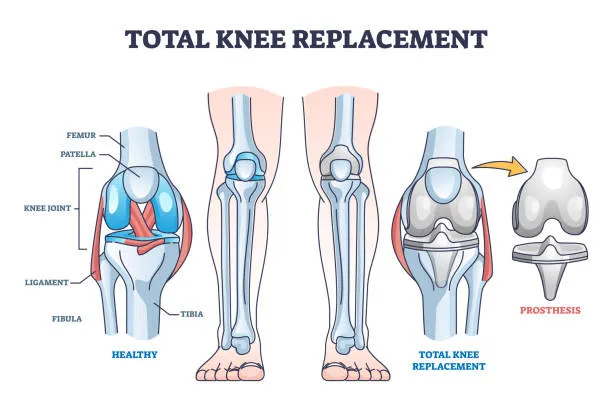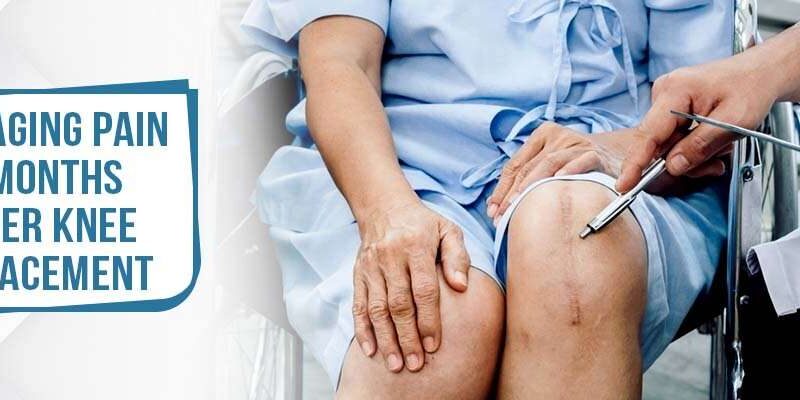Are you suffering from pain 3 months after knee replacement? Consult Dr Sandeep Singh, one of the best orthopedic doctors in Bhubaneshwar, for expert guidance and effective pain management.
Undergoing knee replacement, also known as total knee replacement or knee arthroplasty, is a life-changing decision filled with anticipation and hope. With each step toward the surgery room, patients imagine a future free from the crippling pain hampering their daily lives. As the post-surgery recovery process begins, patients may face new challenges. Consulting with experienced orthopedists can provide personalized treatment options and guidance for managing these challenges effectively, While many people notice a considerable improvement and enjoy increased mobility, others might still struggle with pain.
Are you suffering from pain 3 months after knee replacement? Please consult Dr. Sandeep Singh, widely recognised as the best ortho doctor in Bhubaneshwar, for expert guidance and effective pain management.
In this blog, we examine potential causes of persistent discomfort and go over pain-management techniques for pain 3 months after total knee replacement. This blog will guide you as you travel toward recovery, whether you are looking for assurance, direction, or helpful advice.
Is it normal to have pain 3 months after knee replacement?
“Recuperation is a continuous process, and setbacks might happen along the road,” says Dr. Sandeep Singh, one of the best orthopedist in Bhubaneswar. “You must be patient and not lose hope.”

Possible Causes of Pain 3 Months After Total Knee Replacement (TKR)
Several reasons can cause TKR pain after 3 months. Here are a few potential reasons:
- Swelling and inflammation: Swelling and inflammation in the surrounding tissues can continue for 3 months or more.
- Scar Tissue Formation: Excessive scar tissue growth near the surgery site may cause pain and limited mobility.
- Implant Issues: Pain may be brought on by issues with the knee implant, such as implant loosening, misalignment, or wear and tear.
- Infection: An infection in the knee joint—while uncommon—can still cause lingering discomfort and swelling, even months after surgery
- Nerve injury: Nerve irritation or injury may occur during surgery which can cause persistent pain and sensory changes.
- Muscle Imbalance and Weakness: Poor rehabilitation and strengthening activities can exacerbate muscle imbalance and weakening, which can be uncomfortable.
- Overexertion or Over activity: Excessive exercise or failure to adhere to post-operative instructions can strain the knee joint and cause pain.
- Pre-existing Conditions: Conditions like arthritis, osteoporosis, or autoimmune diseases that already exist might hinder the healing process and increase pain.
- Psychological Factors: Anxiety, depression, and emotional stress can influence the perception of pain and potentially extend the duration of the recovery process.
If you have knee pain 3 months after TKR, please visit orthopedic surgeon Dr. Sandeep Singh to identify the underlying cause of pain and create an effective treatment plan.
Watch Exercises to Manage Pain 3 Months After Knee Replacement Surgery by Dr. Sandeep Singh
Management Strategies for Pain 3 Months After Total Knee Replacement (TKR)
Following are a few management techniques to help reduce TKR pain 3 months post knee replacement:
Following are a few management techniques to help reduce TKR pain 3 months post knee replacement:
“Regular follow-ups with your doctor will help them evaluate your progress, make the required corrections, and offer pain management advice,” advises orthopedic doctor Dr. Sandeep Singh.
Please Consult an Orthopedic Doctor Without Delay If:
- Your pain levels are increasing or becoming unbearable. It may indicate complications or issues with the healing process.
- You are unable to extend or flex your knee fully, or if you notice a decrease in your range of motion. It could be a sign of potential problems with the knee joint replacement or underlying issues.
- You notice significant or persistent swelling. It may indicate infection, implant-related complications, or other issues.
- You experience feelings of instability or if you notice any unusual clicking or grinding sensations in your knee joint. It may suggest problems with the implant or other structural issues.
- You observe signs of infection such as redness, warmth, increased pain, fever, or drainage from the incision site.
“If you have any concerns or questions about your recovery, pain levels, or overall progress after knee replacement operation, it is always wise to consult your orthopedic doctor,” advises Dr. Sandeep Singh, a renowned orthopedist in Bhubaneswar. “They can provide guidance, reassurance, and appropriate medical advice based on your situation.”
FAQs
How Long Does It Take To Walk Normally After Knee Replacement?
How Many Degrees Should Your Knee Bend After Surgery?
The degree of knee bend or flexion after surgery can vary depending on several factors, including the individual’s pre-operative range of motion and the specific surgical technique used. Patients are expected to achieve a range of motion of approximately 110 to 120 degrees. But consult with your healthcare provider for specific targets.
When Does The Pain Stop After Knee Replacement?
Pain resolution varies from person to person. Pain levels decrease significantly within the first few weeks. However, some individuals may experience mild or occasional pain for several months after surgery, especially during physical activities.
What Is Robotic Knee Replacement?
Robotic knee replacement is a minimally invasive surgical technique. It utilizes robotic assistance for precise planning and execution of the knee replacement procedure. It involves using a robotic arm and advanced imaging technology to enhance the accuracy of bone preparation and implant positioning. The surgeon guides the robotic system, providing real-time feedback, enabling optimal alignment, and potentially improving patient outcomes.

